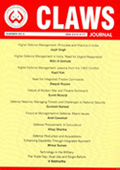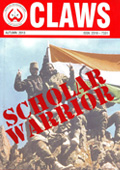| #56 | 1181 | May 16, 2008 | By Praveen Swami | |||||
|
Last month, a coalition of jihadist groups met in Muzaffarabad for its first public gathering since the India-Pakistan crisis of 2001-2002. Hizb ul-Mujahideen chief Mohammad Yusuf Shah, who also chairs the United Jihad Council, promised to “continue jihad in Kashmir until the region is liberated from Indian occupation.” Shah lashed out at Pakistan President Pervez Musharraf for “back-stabbing the Kashmir freedom when it was at its peak in 2001-2002.” Although India had lost hope of crushing the jihad militarily, the Hizb claimed, Gen. Musharraf “under American and western pressure lost his nerve.” Shah’s sentiments weren’t news — and neither was the presence in Pakistan of nominally proscribed organisations such as the Lashkar-e-Taiba, the Harkat ul-Mujahideen or the Harkat ul-Jihad-e-Islami. It is becoming clear, though, that significant changes are afoot in Pakistan. Jaish-e-Mohammad chief Masood Azhar, released from an Indian jail in exchange for hostages on board a hijacked Indian Airlines aircraft in 2000, was recently released from house arrest, and paraded through Bahawalpur with armed supporters. Funding for the Hizb has been stepped up, and the Lashkar, proscribed in 2002, has announced that it will seek legal redress. In its northwest, Pakistan has moved to seek accommodation with the Taliban, initiating a ceasefire with Baitullah Mehsud’s Tehreek-e-Taliban Pakistan. Maulana Sufi Mohammad, founder of the Al-Qaeda-linked Tehreek-e-Nifaz-e-Shariat-e-Mohammadi, has also been released from jail. While most of these moves have been linked to the rise of a new political government in Pakistan, there is little doubt that they are endorsed by its all-powerful military. Just what is driving the army’s efforts to reach a new rapprochement with its historic allies among the clerical order: to rebuild the military-mullah alliance that, even before its institutionalisation during the regime of General Mohammad Zia-ul-Haq, was a pillar of the Pakistan state? Answers could lie in the factional politics of the armed forces. Often cast in terms of stark dualities — secular officers versus Islamists, for example, or westernised elite recruits versus lower middle-class religious fanatics — the army, instead, is the site of complex, shifting contestations that receive little attention in India. A battle for power is raging behind the closed doors of the Pakistan army’s General Headquarters. Last year, signs emerged that the top command was divided within as never before: President Musharraf had to call his corps commanders for conferences a record five times in an effort to develop consensus on policy. Before handing over command to army chief General Ashfaq Kayani in November 2007, President Musharraf took care to appoint his confidants in several key positions. Lieutenant-General Salahuddin Satti, who commanded the critical Rawalpindi-based 111 Brigade during the coup which brought him to power, was made Chief of General Staff. Lieutenant-General Nadeem Taj, Gen. Musharraf’s military secretary at the time of the coup, took charge as Director-General of the Inter-Services Intelligence Directorate. Another of his former military secretaries, Lieutenant-General Shafaatullah Shah, took command of the Lahore corps. Brigadier Asim Saleem Bajwa, who had served as Gen. Musharraf’s deputy military secretary and helped him write his memoirs, was given charge of the 111 Brigade — notorious for acting as the vanguard of each coup in Pakistan’s history. In the six months before he demitted office as army chief, President Musharraf also made a number of critical promotions. Three new corps commanders were appointed —Lieutenant-General Masood Aslam for Peshawar, Khalid Shamim Wayen for Quetta and Raza Mohammad Khan for Bahawalpur. Six more Major-Generals were promoted in September 2007 — a round of appointments that, in the normal course, ought to have been Gen. Kayani’s prerogative. In essence, President Musharraf was ensuring that he retained the ability to control the institutional consensus that drives decision-making in the army. Just why did he do this? On the face of it, General Kayani ought to have been a safe and trusted successor. Having served under President Musharraf as Director-General of Military Operations, commander of X Corps at Rawalpindi, Director-General of the ISI and Vice-Chief of Army Staff, General Kayani was part of the President’s inner circle. Still, as President Musharraf most likely understood, it was inevitable that General Kayani would seek to distance himself from his increasingly unpopular predecessor’s legacy. Signs are that this is precisely what is happening. Early into his tenure as army chief, General Kayani ordered officers to stay away from politicians — a category that, obviously, included the un-uniformed President Musharraf. Less publicly, General Kayani began to demonstrate his authority to the chain of command. He replaced Lieutenant-General Jami Haider, who Gen. Musharraf chose to head the new C4I Directorate — short for Command, Control, Communications and Intelligence. Some observers believe that the changes at the C4I Directorate mark an effort to create counterweights to President Musharraf’s control of the ISI through Lieutenant-General Nadeem Taj. Director-General of Military Intelligence Nadeem Ijaz, a relative of President Musharraf and key protagonist in the management of the Lal Masjid standoff in Islamabad and the sacking of Chief Justice Iftikhar Chaudhry, was moved to a politically inconsequential command in Bahawalpur. Promotions of brigadiers to the rank of major-generals, scheduled for January, were put on hold in another effort to drive home the point that sources of patronage within the army had changed. And when President Musharraf sought to promote his military secretary Major-General Shafqat Ahmad to the rank of Lieutenant-General and designate him Chief of Staff, the GHQ rejected the request. Historical precedents exist for the Kayani-Musharraf relationship. Field Marshal Mohammad Ayub Khan handed over charge of the army to General Agha Muhammad Yahya Khan, while retaining political control of Pakistan. General Yahya had been mentored by Ayub through most of his career, but he soon found it expedient to allow his predecessor to be blamed for the multiple political crises Pakistan was beset with. Over time, Field Marshal Ayub’s orders were often stonewalled by the army chief, and a team of handpicked officers from the GHQ took over the administration of his office. Field Marshal Ayub was thus marginalised by his own protégé. Gen. Kayani freeing of restraints on jihadists, it seems probable, is part of the unfolding of a similar institutional power struggle process. Often characterised as a secular, pro-United States professional, he is demonstrating that he, like President Musharraf, is also a ruthless political animal. President Musharraf’s confrontation with the army’s Islamist allies was, from the outset, unpopular among substantial sections of the military. Most officers believed that aid flows from the U.S. were not commensurate with the costs of the murderous conflict they were engaged in against their one-time Islamist clients in Pakistan’s northwest. Moreover, many in the army believed that the war could spiral into an existential threat for Pakistan. By reopening lines of communication with jihadists, General Kayani is signalling to his rank and file that he is responsive to these concerns — and placating Islamist officers hostile to President Musharraf. Useful political function
Ironically, elements in the PPP could also find it expedient to build links with jihadist organisations like the Jaish-e-Mohammad, to forge a common front against their common Mohajir Quami Movement adversaries in Karachi. How significant will the renewed military-mullah alliance prove? While most Indian analysts expect an increase of violence in Jammu and Kashmir in the run-up to the Assembly elections this autumn, few expect Pakistan to risk precipitating a crisis along the eastern border — particularly given that much of its northern army reserve is denuded by commitments in the North West Frontier Province. Nor do experts believe that Pakistan’s efforts to reach accommodation with Islamists in the NWFP will prove durable. On April 25, days after Baitullah Mehsud circulated pamphlets asking his forces to cease fire, terrorists bombed a police station in Malakand, killing four persons and injuring 30. In a speech delivered at the Jamia Masjid al-Qudsia in Lahore on April 25, the Lashkar’s spiritual and political patron Hafiz Mohammad Saeed laid out just how the jihadists see Pakistan’s political situation. “Former Pakistani rulers and politicians,” he said, “took pride in being servile to foreign powers. Even though there are still many such people in Islamabad, there is no dearth of those Muslims too who believe in looking the enemy in the eye. These are the ones who truly represent Islam and Muslims. The new government has two choices. One is to adopt servility. This will greatly please the enemies of Islam but it will anger Allah. The other way is to desist from disobeying Allah. In turn, Allah will open the doors of His mercy and the current crises of water, flour, and electricity will be resolved.” Saeed is right: the Army is indeed at the crossroads — and at not a little risk of once again becoming hostage to the forces it is seeking accommodation with. (Courtesy: The Hindu, May 15, 2008) Disclaimer: The views expressed in this article are those of the author and do not represent the views either of the Editorial Committee or the Centre for Land Warfare Studies.
| ||||||||
| ||||||||

|
Praveen Swami |


